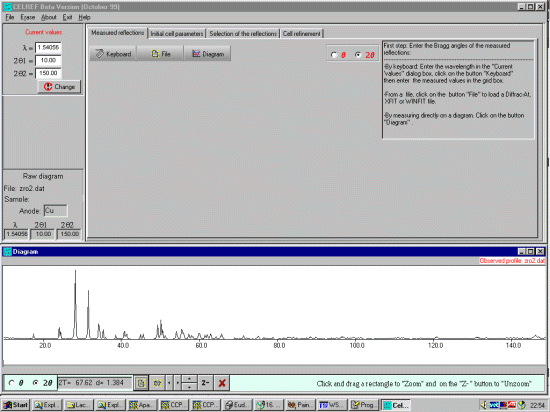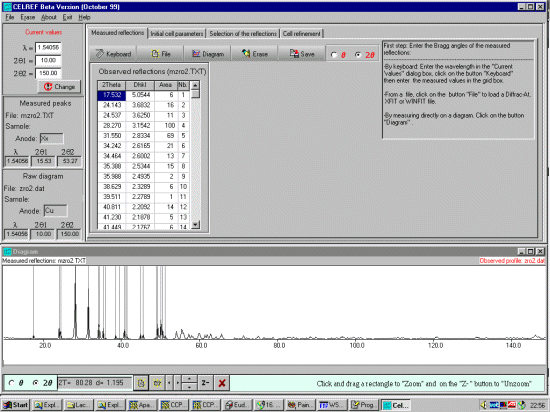
CELREF: Graphical Unit Cell refinement.
7th September 1999 E-mail from Jean Laugier
"Generally I should like to make some remarks about the cell parameters measurements:
-The precision of the refinement of the cell parameters are not
proportionnal to the number of peaks treated by the program. It is always
better, when it is possible, to use peaks above 45°, mainly because the
vertical divergence changes at this value. For a cubic structure, for
example, it is better to measure only one peak at the maximum Theta angle
than to use Celref with a lot of peaks, if the zero shift is weak or known!
-In the Least Square method it is assumed that the errors are random and in
an experimental diagram the errors are totally systematic! It is necessary
to be suspicious about the parameters precisions given by the program.
-The mathematical method does not work very well with cubic structures, if
the starting a value is very different of the true value. it is always
better to refine the zero shift in this case. (The batch bersion works in
ILL since 20 years and nobody saw that! Probably they never refine cubic
cells!).
Perhaps it would be necessary to make a special algorithm for the cubic case..."
| CELREF can be obtained off the web at the the LMGP (Laboratoire des Materiaux et du Génie Physique de l'Ecole Supérieure de Physique de Grenoble http://www.inpg.fr/LMGP/) program suite site at http://www.ccp14.ac.uk/ccp/web-mirrors/lmgp-laugier-bochu/ |
The example data file is of monoclinic Zirconia used in the
Rietveld Round Robin (Hill and Cranswick)
Wavelength: 1.54056 1.54439 (Cu K alpha - Philips Diffractometer) Monoclinic ZrO2 SG: P 21/C Cell: 5.1471 5.2129 5.3141 90.0000 99.2224 90.0000 ZR ZR+4 0.27566 0.04011 0.20906 0.08229 0.98650 HF HF+4 0.27566 0.04011 0.20906 0.08229 0.01350 O1 O-2 0.07027 0.33247 0.34197 0.72209 1.00000 O2 O-2 0.45011 0.75639 0.47740 0.59420 1.00000
|
|
Click on the CELREF icon or run the program via the windows explorer/windows file manager to
bring up the CELREF starting interface.

|
|
You can then open a Powder diffraction data file using either the
File, Open, Profile menu option or the the bottom left
hand set of ICONs (Celref can presently use Siemens/Bruker RAW, CPI or RIET7 DAT
raw datafiles). In this case we open a mzro2.dat file. CELREF will prompt for
the Wavelength of the peak file. Select Other and type in the wavelength: 1.54056
Angstrom (Cu k Alpha 1).

|
|
Either type the reflections in by hand or open a peak find/peak profile file
either via the File, Open, Peaks File or the ICON under the Measured Reflections tab.
The peaks will be displayed on the bottom window. (Celref can presently import Siemens/Bruker DIF,
Winfit *.DAT, or XFIT *.TXT peak find/peak profile output files). If loading an XFIT or related file
(in this case we open a Y2O3.dat file), when prompted for wavelength select OTHER and confirm the
wavelength being used (1.54056 Angstrom) and continue.

|
|
Select the Initial Cell Parameters tab. Input the (approximate) Cell, Spacegroup and calculation range information then press the Calc Button to generate the HKL listing. It is also possible to load this from a file if this information exists. Just click the File tab under the "Selected" Initial Cell Parameters tab and load the relevant *.cry file).

|
|
Select the Selection of the Reflections tab. To select the corresponding peaks, this can be done manually or automatically (with a controllable angular tolerance). Click on the Automatic Selection button to automatically select the corresponding peaks. Check both the top peak list and the bottom graphical representation to see that the selection has occured appropratiately. Peaks can be added or deleted manually. Be careful to check that Celref hasn't duplicated HKLs due to poor quality input data.

|
|
Select the Cell Refinement tab. At this point, recheck that the wavelength is correct, CELREF may be using the average alpha wavelength when you are profiled the peaks on the Alpha-1 wavelength. If you wish to change the wavelength, you can do this in the top left Current Values option area and click on the Red Change button. Click on the Compute button to perform the unitcell refinement. Two-theta offset can also be refined. If you click on this, Celref will prompt whether you wish to use model a constant zero shift or a sample exentricity. If you keep the unitcell constants at known values, the wavelength can be refined.

|
|
You can see all the results in a file using the Print ICON. Which is
normally outputted in a file called celref.out
----------------------------------------------------
No Title
----------------------------------------------------
Number of reflections : 21
Max. number of refinement cycles 10
Refinement constraints : NO
Initial values :
Zero Lambda a b c alpha beta gamma
.00000 1.54056 5.1471 5.2129 5.3141 90.00 99.22 90.00
1. 0. 1. 1. 1. 0. 1. 0.
Recipr.lattice : .1968 .1918 .1906 90.00 80.78 90.00
Volume (a**3) : 140.741
Number of refinement cycles : 5
Final values : (Standard errors on 2nd line)
Zero Lambda a b c alpha beta gamma
.00174 1.54056 5.1491 5.2140 5.3165 90.00 99.23 90.00
.00059 .00000 .0002 .0002 .0002 .00 .00 .00
Recipr.lattice : .1968 .1918 .1906 90.00 80.77 90.00
Volume (a**3) : 140.887
H K L 2Th(obs) 2Th-Zero 2Th(Calc) diff.
1 0 0 17.532 17.530 17.532 -.002
0 1 1 24.143 24.141 24.138 .003
1 1 0 24.537 24.535 24.535 .000
-1 1 1 28.270 28.268 28.263 .005
1 1 1 31.550 31.548 31.552 -.004
0 0 2 34.242 34.240 34.241 -.001
0 2 0 34.464 34.462 34.468 -.006
2 0 0 35.388 35.386 35.387 -.001
-1 0 2 35.988 35.986 35.979 .007
0 2 1 38.629 38.627 38.625 .002
2 1 0 39.511 39.509 39.510 -.001
-2 1 1 40.811 40.809 40.806 .003
1 0 2 41.230 41.228 41.233 -.004
-1 2 1 41.449 41.447 41.452 -.005
1 1 2 44.906 44.904 44.903 .002
2 1 1 45.599 45.597 45.593 .004
-2 1 2 48.992 48.990 49.003 -.013
0 2 2 49.327 49.325 49.327 -.002
2 2 0 50.186 50.184 50.183 .001
-1 -2 2 50.638 50.636 50.631 .005
-2 2 1 51.269 51.267 51.262 .005
Sqrt(Sum(Th O-C)**2)/(Nref-Npar)) = .001343
Sqrt(Sum(2Th O-C)**2)/(Nref-Npar)) = .000671
|